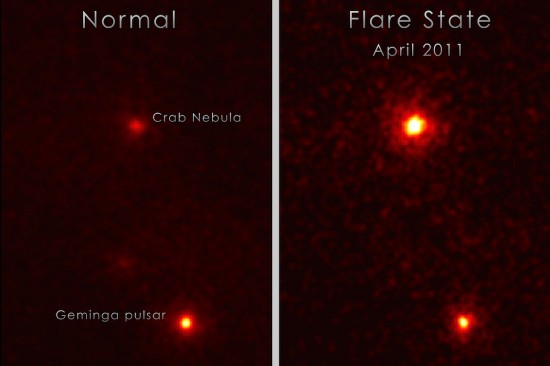Oct 17, 2014
The Crab Nebula is surprisingly energetic.
The Fermi Gamma-ray Space Telescope has detected several unidentified sources of intense gamma-ray emissions that are not seen in any other frequencies. NASA launched the telescope on June 11, 2008. Its primary mission is to detect high frequency electromagnetic waves in space, including gamma-rays. Since gamma-rays are unable to penetrate Earth’s atmosphere, Fermi was placed in high orbit.
Gamma-rays are theoretical “electromagnetic particles” called photons. Due to the supposed “duality” of matter, they exist as both waves and particles, and they are “massless,” as astrophysicists define mass. However, since they travel at enormous velocity (up to 2.993 x 10^10 centimeters per second), so-called “relativistic effects” come into play. As consensus theories state, the velocity imparts significant momentum to the photons, enough for them to have an impact on normal matter. Thus, gamma-rays are “ionizing radiation,” since they are capable of knocking electrons out of an atom.
Of the three types of natural radioactivity, gamma rays are the most energetic, with values 10^15 times greater than visible light. They also have short wavelengths, less than 0.1 nanometers, in some instances.
One of Fermi’s recent discoveries concerns the Crab Nebula. For many years, astronomers thought that the Crab Nebula was well known, with a steady X-ray glow. Fermi found that it is emitting gamma-ray bursts so strong that they are reconsidering their theories. “Super flares” of gamma radiation are blasting out from the nebula, their intensity rapidly rising and falling.
Alice Harding at NASA’s Goddard Space Flight Center in Greenbelt, Maryland reported: “These super flares are the most intense outbursts we’ve seen to date, and they are all extremely puzzling events. We think they are caused by sudden rearrangements of the magnetic field not far from the neutron star, but exactly where that’s happening remains a mystery.”
The mystery is solved when the fact is considered that charged particles accelerated in an electric field emit synchrotron radiation that often takes the form of X-rays and gamma-rays. Laboratory experiments have confirmed that that is the “easiest” way to create them. They are not created in gravity fields. No so-called “pulsars,” “neutron stars,” or near-infinite masses compressed into infinitesimal volumes are necessary. There are far more mundane factors that should be considered when analyzing data from space before resorting to super-dense objects and other exotic fictions.
As noted in the past, Hannes Alfvén thought that the “exploding double layer” should be considered a new class of celestial object. It is double layers in space plasmas that form most of the unusual structures we see. Compression zones (z-pinches) in plasma filaments create plasmoids that evolve into stars and galaxies. Electricity is responsible for the birth of stars, and when the current density gets too high the double layers in the circuit catastrophically release their excess energy and appear as gamma-ray bursts, X-rays or flares of ultraviolet light.
As Alfvén said in his 1970 Nobel Prize acceptance speech: “… it is obvious that astrophysics runs the risk of getting too speculative, unless it tries very hard to keep contact with laboratory physics. Indeed it is essential to stress that astrophysics is essentially an application to cosmic phenomena of the laws of nature found in the laboratory. From this follows that a particular field of astrophysics is not ripe for a scientific approach before experimental physics has reached a certain state of development.”
Stephen Smith













